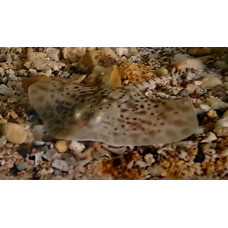Latin name
Raja clavata
Other names
Raja clavata
Identification
The body is rhomboid, the head is short and the wing-like pectoral fins are pointed at the ends. The upper side is rough and spiny, covered with a pattern of light and dark spots. The underside is white. There are two small dorsal fins on the back of the tail, covered with light and dark cross-strips. A row of slender, needle-like spines on the back and upper part of the tail is characteristic. Adults have additional spines on the upper and lower wings.
Distribution
Occupies the east coast of the Atlantic Ocean from Iceland, Norway and the North Sea to South Africa. Present in the Mediterranean, Black Sea and has been found in the Sea of Azov.
Habitat
They inhabit sandy and muddy seabeds at depths of 20 to 300 metres. In the eastern Ionian Sea, they have been found at depths of up to 577 metres.
Size
Males reach about 50 cm (20 in) in width at first maturity, about seven years after birth; females reach 60-70 cm (24-28 in) at first maturity, nine years after birth. The average weight is about 10 lb (4.53 kg). Larger fish can weigh 9.07 kg (20 lb) or more.
Life history and Behavior
Sexual maturity occurs at about seven to eight years of age, usually earlier in males than in females. The maximum lifespan of this species is 15 years.
Food and feeding habits
They feed on bottom dwelling invertebrates, mainly crustaceans, and small fish.
Reproduction
Like all rays, thornback ray are characterised by egg-laying. Mating takes place in spring. The females then lay one egg a day for several weeks, with a total of 50 to 170 eggs per year. The eggs hatch within four to five months. The hatchlings are 4.3 to 5.1 centimetres long. They survive by feeding on the yolk of the eggs.
| Classification | |
| Phylum | Chordata |
| Class | Chondrichthyes |
| Squad | Rajiformes |
| Family | Rajidae |
| Genus | Raja |
| Species | R. clavata |
| Features | |
| Conservation status | Near Threatened |
| Habitat | Bottom |
| Life span, years | 15 |
| Maximum body weight, kg | 9,07 |
| Maximum length, cm | 70 |
| Sailing speed, m/s | No information |
| Threat to people | Edible |
| Way of eating | Predator |
Thornback ray
Tags: thornback ray



